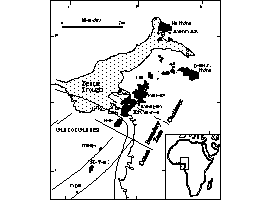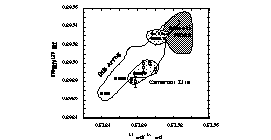
The Cameroon line is a 1600km long Y-shaped chain of <65 Ma old intraplate plutonic and volcanic centers, extending from the island of Pagalu in the SW to the Biu and Ngaoundere plateaus in the NE (Fig. 1). Young basaltic lavas are identical in composition in both oceanic and continental sectors, suggesting that the lavas have been derived from sublithospheric depths ( Fitton and Dunlop, 1985). Samples from the volcanic centers of Mt. Cameroon and Etinde and the island of Bioko on the Continental- Oceanic Boundary (COB) however, are quite distinct. These regions display relatively radiogenic Pb with a systematic decrease in 206Pb/204Pb and 208Pb/204Pb from the COB towards either end of the volcanic chain. This has been interpreted in terms of remelting of an enriched fossil plume head located beneath the COB, emplaced during continental breakup in the present Gulf of Guinea (Halliday et al., 1988; Halliday et al., 1990). The age of the earliest exposed volcanics in the island chain decrease oceanward from Principe (31Ma) to São Tomé (13Ma) to Pagalu (4.8Ma) and are consistent with the motion of the African Plate over this time. Although the average trace element composition for lavas <10Ma is similar, (87Sr/86Sr)t increases from 0.7029 to 0.7037 and (206Pb/204Pb)t decreases from 20.2 to 18.9 from Principe through São Tomé to Pagalu. Samples from Principe and São Tomé have become progressively more radiogenic Pb with time, with the earliest lavas from Principe (31Ma) and São Tomé(13Ma) having very similar isotopic compositions to that of Pagalu. The isotopic composition of Pagalu appears to have remained constant with the least radiogenic Pb and most radiogenic Nd compositions observed in the Cameroon line. These observations are interpreted as supporting a model in which the common source for all islands is an ambient upper mantle entrained within a plume head during ascent. The progression to radiogenic Pb in Principe and São Tomé reflects the increasing importance of an active plume stem, composed of relatively uncontaminated HIMU mantle, supplying the magmatic systems (Lee et al., 1994).
Hf isotopes are in general correlated with Nd isotopes in mantle-derived materials (Patchett, 1983) and have only recently received more than limited attention in mantle studies. As with Sm/Nd, the Lu/Hf ratio in MORB does not support the measured 176Hf/177Hf ratios, and must represent recent processes of either metasomatism or melting within the garnet stability field (Salters and Hart, 1989). The detailed spatial, temporal and geochemical constraints already available for the Cameroon Line (Fitton and Dunlop, 1985; Halliday et al., 1988; Halliday et al., 1990; Lee et al., 1994) provide an ideal location to investigate further the controls on the evolution of Hf isotopes in oceanic, continental and transition zone volcanic systems. Initial data, measured by ICP magnetic sector multiple collector mass spectrometry (MC-ICPMS) are consistent with a HIMU source mixing with a more depleted mantle composition (Fig. 2). These data endorse earlier conclusions based on Pb and Nd isotopes that the components are derived from sub-lithosphere depths with no systematic difference between magmas erupted through continental and oceanic lithosphere.
Fitton, J.G. & Dunlop, H.M., EPSL 72, 23-38 (1985).
Halliday, A.N. et al., J. Pet. 29, 181-211 (1988).
Halliday, A.N. et al., Nature 347, 523-528 (1990).
Lee, D.C., et al. EPSL 123, 119-138 (1994).
Patchett, P.J., GCA 47, 81-91 (1983).
Salters, V.J.M. & Hart, S.R., Nature 342, 420-422 (1989). 
Fig. 1: Geological map showing the major Cenozoic volcanic centers of the Cameroon line. 
Fig. 2: Hf-Nd isotope correlation diagram showing initial Hf results from Cameroon line samples. 2* errors shown. Fields for oceanic volcanics and MORB are taken from Salters and Zindler EPSL 129, 13-30 (1995).